Drought conditions are slowly improving across Puerto Rico and the U.S. Virgin Islands with long-term forecasts suggesting increased chances for above-normal rainfall over the next few months.
Key Points
- Puerto Rico Conditions: Recent heavy rains proved to be quite beneficial, falling in the locations that needed it most. Drought conditions improved across most of the island with only the southern coast from Cayey and Guayama westward seeing deficits at the 6-month time period of 8 to 12 inches, as well as the municipalities of Canovanas and Rio Grande. The rest of the island is near-normal to above-normal for rainfall at the 6-month time frame.
- U.S Virgin Islands Conditions: All major islands in the USVI are currently experiencing drier-than-normal weather. Long-term moderate drought (D1) continues on St. Croix, where groundwater levels remain low, and long-term precipitation deficits remain. Abnormal dryness (D0) has recently developed on St. Thomas, where groundwater levels decreased and short-term precipitation deficits mounted. Drought-free conditions continued on St. John this week.
- Puerto Rico Impacts: Soil moisture and streamflows continue to show signs of recovering with a decrease in the fire danger threat as well.
- U.S. Virgin Islands Impacts: Intermittent rainfall territory-wide is slowly recharging ponds and collection containers. While drought conditions have improved, normal recharge of water supply is still not being seen across St. Thomas and St. Croix, which is concerning to many farmers as they store much of the water they use at this time. In particular, groundwater tables in St. Croix show a marked decrease (see groundwater section below).
- Looking Ahead: Long-term forecasts continue to suggest normal to above-normal rainfall across the local islands through the end of the year. Rainfall during November will be key going into the dry months of December through May. Average rainfall in November across the USVI is about double what it is for December. With slightly higher probabilities of above-normal rainfall forecast in November for the USVI, this could be a huge boost for groundwater and surface water levels as the dry winter and spring months approach.
- For weather information specific to your area, please monitor products issued by the National Weather Service in San Juan.
U.S. Drought Monitor map for Puerto Rico, as of November 2, 2021. The U.S. Drought Monitor is updated each Thursday to show the location and intensity of drought across the country.
Nearly 35% of Puerto Rico is classified as being Abnormally Dry (D0) by the US Drought Monitor, while only 2% of the island is now classified as having Moderate Drought (D1).
U.S. Drought Monitor map for the U.S. Virgin Islands, as of November 2, 2021. The U.S. Drought Monitor is updated each Thursday to show the location and intensity of drought across the country.
Moderate (D1) drought conditions are still observed across St. Croix. St. Thomas is classified as being Abnormally Dry (D0), with St. John remaining drought-free.
U.S. Drought Monitor Categories
U.S. Drought Monitor map for Puerto Rico, as of November 2, 2021. The U.S. Drought Monitor is updated each Thursday to show the location and intensity of drought across the country.
Nearly 35% of Puerto Rico is classified as being Abnormally Dry (D0) by the US Drought Monitor, while only 2% of the island is now classified as having Moderate Drought (D1).
U.S. Drought Monitor map for the U.S. Virgin Islands, as of November 2, 2021. The U.S. Drought Monitor is updated each Thursday to show the location and intensity of drought across the country.
Moderate (D1) drought conditions are still observed across St. Croix. St. Thomas is classified as being Abnormally Dry (D0), with St. John remaining drought-free.
Current Conditions
Rainfall Deficits
Puerto Rico and U.S. Virgin Islands: The 90-day rainfall deficits now range between 2 and 4 inches along the southern coast of Puerto Rico and parts of the east central interior (Figure 1). In the USVI, the Cyril King Airport weather station and the Rohlsen Airport weather station report deficits of 4 to 5 inches in the past 90 days. The year-to-date deficit at Rohlsen Airport is now nearly 9.5 inches.
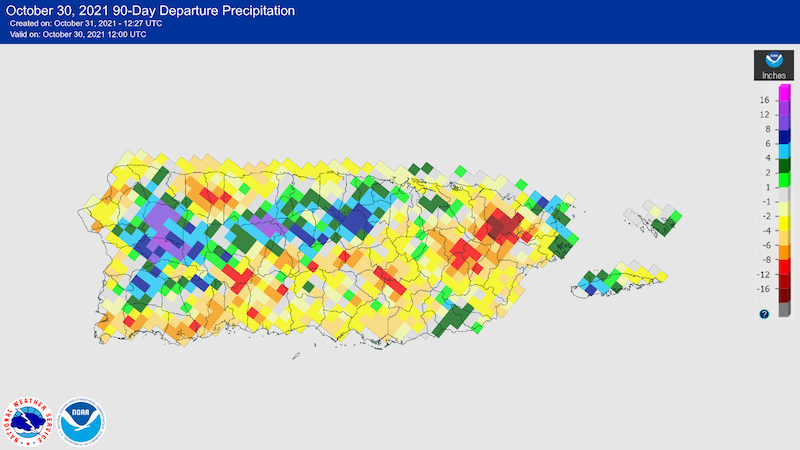
Soil Moisture Conditions in Puerto Rico
Although data retrieved from the Puerto Rico Agricultural Water Management (PRAGWATER) continue to indicate drier-than-normal soils across some areas, soil moisture conditions improved particularly across the southern slopes and the eastern interior of the island (Figures 2 and 3).
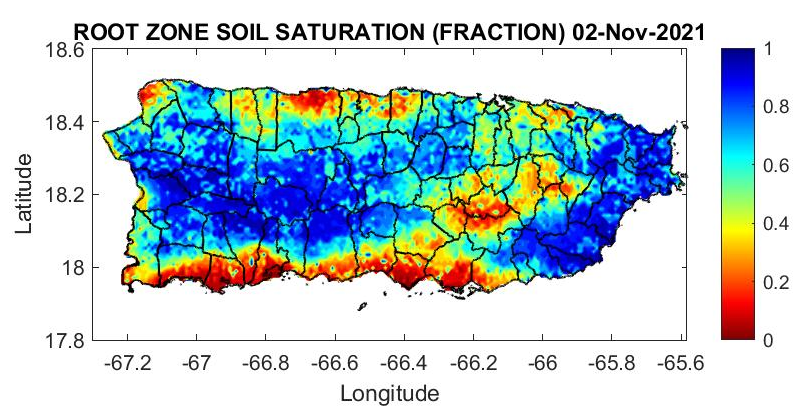
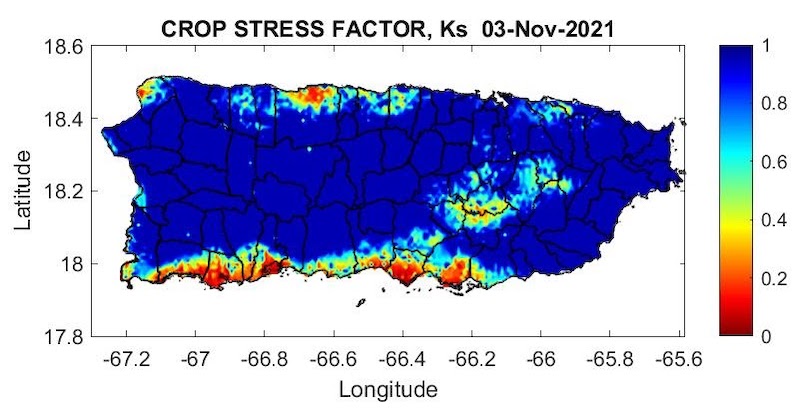
Streamflow Conditions in Puerto Rico
The 28-day average streamflow measured by the U.S. Geological Survey (USGS) gaging network shows most of the streamflows now running at normal or above-normal levels (Figure 4).
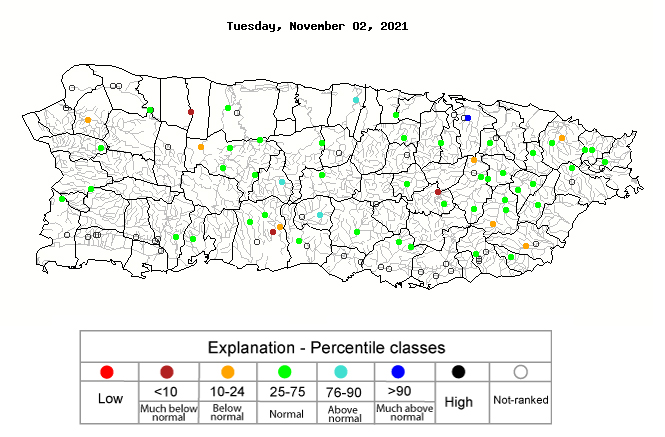
Groundwater Conditions
- The groundwater levels retrieved from the U.S. Geological Survey network indicated improvements across the southern and northern slopes of Puerto Rico as well as Saint Thomas. Nevertheless, there are still some aquifers running below normal values across south and north Puerto Rico (Figure 5).
- The U.S. Geological Survey well data continues to reflect the impacts of long-term drought on groundwater, especially on St. Croix. The USGS Adventure 28 Well on St. Croix has not responded to the 2021 rainy season, with depth to water continuing to increase (to greater than 25 feet) in recent months. The only other time depth to water was greater than 25 feet at that location occurred in the early days of the well’s operation, in 2016, near the end of a punishing, multi-year drought (Figure 6).
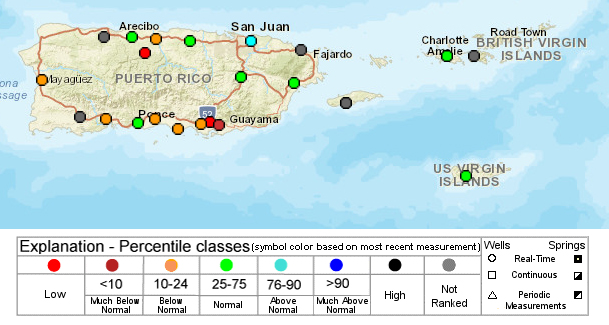
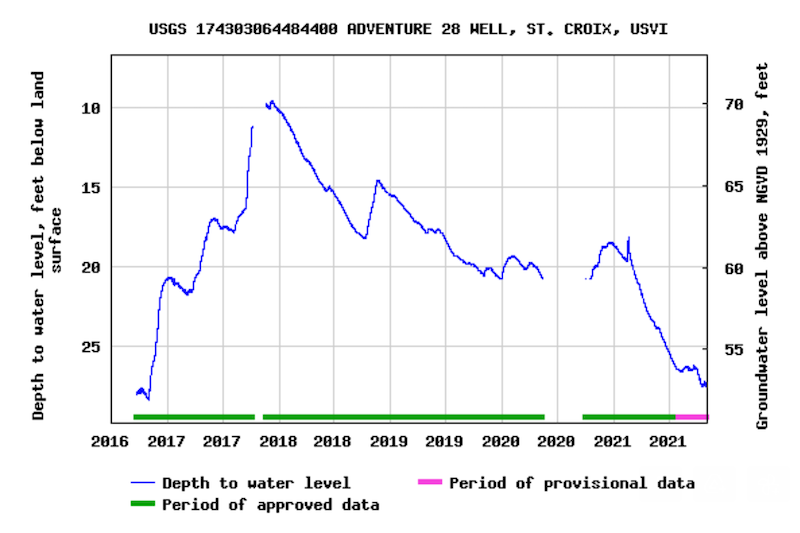
Outlooks and Impacts
Rainfall Outlook
Based on the probabilistic 3-month extended forecast by the Caribbean Climate Outlook Forum (CariCOF), there is a higher chance to observe near- to above-normal rainfall through at least January 2022 (Figure 7).
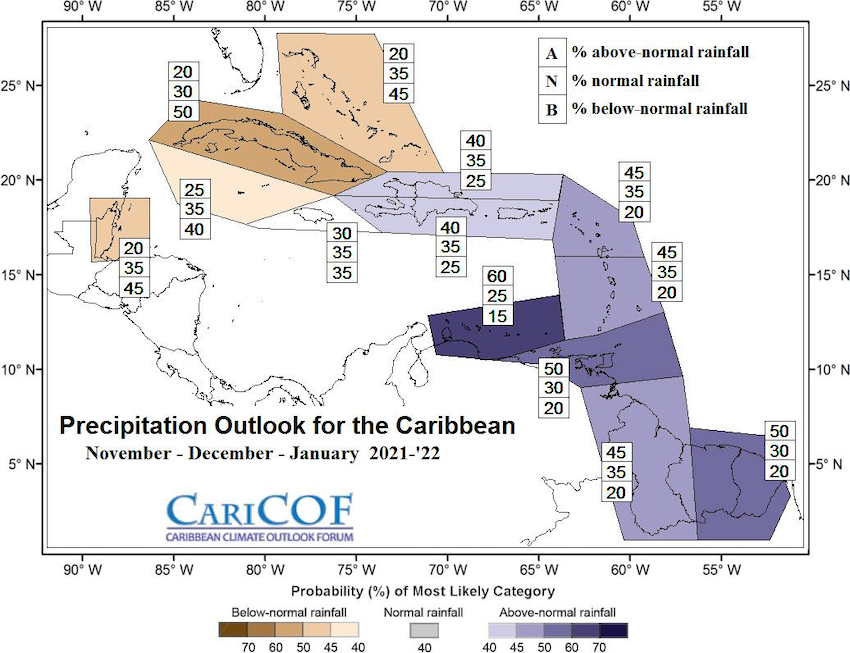
Sector Impacts
General Conditions
- Puerto Rico: Recent rains have improved conditions for most of the island with some persistent 90-day rainfall deficits along the south coast and east central regions where continued rain will improve conditions.
- U.S. Virgin Islands: All major islands in the USVI are currently experiencing drier-than-normal weather. While drought conditions have improved, winds have impacted soil moisture. Currently, St Croix remains at D1, while St Thomas is experiencing D0. Neither dryness nor drought is being depicted for St John. However, normal expectations of precipitation levels are not being seen during this time which is concerning to many farmers as they store much of the water they use at this time. In addition, groundwater tables still show a decrease in water availability.
Agricultural Conditions
- Puerto Rico: Increased rainfall has been beneficial in improving soil moisture conditions for agricultural activity across the island, while some heavy rain events have had a moderate impact on getting into the field. Reports in the southwest region cite periods of heavy rains, leading to saturated soils and high water levels in some rivers.
- St. Thomas: Farmers are reporting intermittent and sporadic rain, and trees and vegetation are responding. Even though there is no drought, long-term indicators are concerning to farmers who have little access to water. Poultry farmers who have access to grass are reporting a rise in vegetation for feed. Water conservation methods are still in place at this time and many are working on long-term irrigation plans as it appears changing climate is resulting in more frequent and longer-lasting droughts.
- St. John: Farmers are reporting that rain has increased, but it is still sporadic. Vegetation is currently recovering, but the soil is not retaining as much moisture as farmers had hoped for at this time. Farmers are also continuing conservation practices and have adapted their methods; they regulate irrigation practices in the early morning and late afternoon to maximize water resources and are working on long-term irrigation methods to increase conservation practices. It should be noted that in St John, the largest private pond is still not full which is of concern as it is normally running over at this time of year.
- St. Croix: Drought conditions remain in St Croix as the USDM is reporting a long-term D1 level for the island. While some rain has fallen and farmers are continuing to report signs of vegetation returning to green, farms of all sizes are reporting that intermittent heat conditions are still affecting their ability to retain soil moisture and water. The VI Department of Agriculture (VIDA) reported that, on St Croix, water deliveries to the agricultural community included more than 968,850 gallons in September. In October, water deliveries were listed as 1,048,438 gallons. One large producer reported going from purchasing 8,000 gallons of water per week to up to 12,000 gallons per week. Since drought conditions continue overall, livestock farmers are still planning mitigation efforts to rotate livestock to feed them. However, livestock farmers on St Croix are no longer seeking to purchase feed as chop as it is available. Nevertheless, the long-term drought indicators are creating an underlying need for additional irrigation systems in the fields. Poultry farmers are reporting increased water in cisterns but decreased production due to not being able to get chicks mailed in due to postage delays, and are concerned that water impacts for poultry needs are not bouncing back as quickly as they should at this time of the year. As a result, they are experiencing a decrease in egg production, partly caused by extreme heat and drought throughout the year.
For More Information
- National Weather Service (NWS) Weather Forecast Office – San Juan: Climate and Drought Information
- NWS Drought Information Statements for Puerto Rico and the U.S. Caribbean
- Drought.gov:
- Caribbean Drought Bulletins. Caribbean Regional Climate Center, Caribbean Institute for Meteorology and Hydrology (CIMH), Barbados
- U.S. Department of Agriculture (USDA) Caribbean Climate Hub drought and disaster assistance resources for tropical forestry and agriculture
Prepared By
Odalys Martinez
NWS Weather Forecast Office – San Juan
Meredith Muth
NOAA/National Integrated Drought Information System (NIDIS)
Victor Murphy
National Weather Service Southern Region
Christina Chanes, Gregory Guannel
University of the Virgin Islands
William Gould, Nora Álvarez-Berríos, and Eva Holupchinski
USDA Caribbean Climate Hub, USFS International Institute of Tropical Forestry
Brad Rippey
USDA Office of the Chief Economist
Héctor J. Jiménez
Office of Climatology, University of Puerto Rico
Puerto Rico Reporting Input: Thanks to the Agricultural Extension Service, College of Agricultural Sciences, University of Puerto Rico-Mayaguez. Thanks to Prof José L Zamora, Agricultural Extension Service, RUM-UPR, and Eric Harmsen, Professor of Agricultural Engineering UPR.
USVI Reporting Input: Several individuals contributed to this report, and we are acknowledging the following for their support, including the faculty, staff and collaborators of the UVI Physics Program, UVI Etelman Observatory, UVI Agricultural Experiment Station, VI Department of Agriculture, UVI Caribbean Green Technology Center, as well as the USDA Office of the Chief Economist, National Parks Service in St. Croix, USDA Farm Service Agency, Coral Bay Community Council, and the many volunteers, drought reporters, and farmers from across the territory.
About This Report
This drought update is issued in partnership between the National Integrated Drought Information System (NIDIS), National Oceanic and Atmospheric Administration (NOAA) National Weather Service, the U.S. Department of Agriculture (USDA), and the University of the Virgin Islands. The purpose of the update is to communicate a potential area of concern for drought expansion and/or development within Puerto Rico and the U.S. Virgin Islands based on recent conditions and the upcoming three-month forecast.
NIDIS and its partners will issue these updates every two months. Subscribe for these U.S. Caribbean drought updates here.





